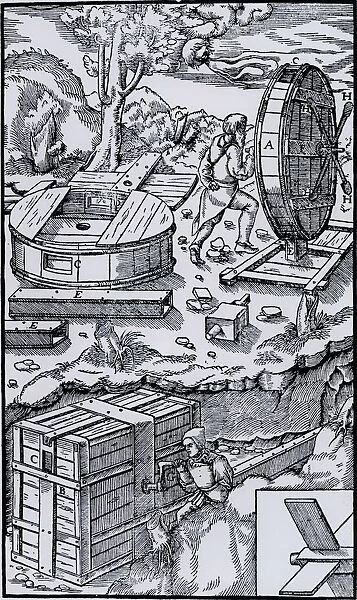Home > Universal Images Group (UIG) > History
Mine ventilation. Hollow wooden drum, top, which had two blowholes opposite each
Only Available in the UK and Ireland
![]()

Wall Art and Photo Gifts from Universal Images Group (UIG)
Mine ventilation. Hollow wooden drum, top, which had two blowholes opposite each
Mine ventilation. Hollow wooden drum, top, which had two blowholes opposite each other on the circumference, C, one to suck in air and one to expel it as the drum rotated. Inside the drum, fixed to axle on which it rotated, were fans made of wood or of wood and goose quills. HHHH are rods attached to the axle and which acted as a flywheel. Hollow box, bottom, similar to the drum above, but not considered to be as efficient. From De re metallica, by Agricola, pseudonym of Georg Bauer (Basle, 1556). Woodcut
Universal Images Group (UIG) manages distribution for many leading specialist agencies worldwide
Media ID 9752405
© Universal History Archive/Universal Images Group
1556 Acted Agricola Attached Basle Bauer Bottom Considered Drum Fans Fixed Georg Goose Hollow Inside Metallica Mine Mining Opposite Pseudonym Quills Rods Similar Ventilation Wood Woodcut Wooden Axle Blowholes Circumference Efficient Expel Flywheel Rotated Suck
FEATURES IN THESE COLLECTIONS
> Animals
> Birds
> Waterfowl
> Geese
> Related Images
> Universal Images Group (UIG)
> History
EDITORS COMMENTS
This print takes us back in time to the world of mine ventilation during the 16th century. The image showcases a fascinating contraption designed to regulate air flow deep underground. At the center of attention is a hollow wooden drum, positioned at the top, featuring two blowholes placed opposite each other on its circumference. These blowholes served distinct purposes - one to draw fresh air into the mine and another to expel stale air as the drum rotated. Inside this ingenious device were fans meticulously crafted from wood or a combination of wood and goose quills. These fans were fixed onto an axle that allowed them to rotate along with the drum, effectively circulating much-needed airflow within the mining tunnels. To enhance stability and balance, rods known as HHHH were attached to act as flywheels. Interestingly, right below this remarkable drum sits a hollow box similar in design but considered less efficient for ventilation purposes. This lower chamber was likely used for alternative functions within mining operations. The historical significance of this image lies not only in its depiction of early mine ventilation techniques but also in its origin from "De re metallica" written by Georg Bauer under his pseudonym Agricola in Basle back in 1556. This woodcut illustration offers us a glimpse into an era when innovation and resourcefulness played crucial roles in ensuring safe working conditions for miners deep underground.
MADE IN THE UK
Safe Shipping with 30 Day Money Back Guarantee
FREE PERSONALISATION*
We are proud to offer a range of customisation features including Personalised Captions, Color Filters and Picture Zoom Tools
SECURE PAYMENTS
We happily accept a wide range of payment options so you can pay for the things you need in the way that is most convenient for you
* Options may vary by product and licensing agreement. Zoomed Pictures can be adjusted in the Cart.

